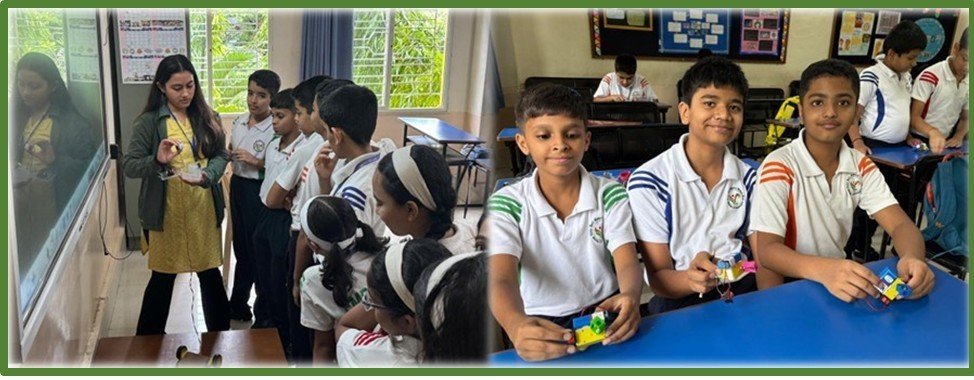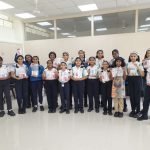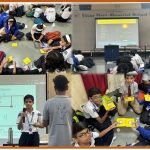
ROBOTICS CLUB 2025-26
REPORT FOR THIRD ACTIVITY 26 th July 2025
A Robotics club is a gathering of students who are interested in learning about and working with Industrial Robots. Students acquire deeper knowledge through active exploration of real-world challenges and problems. Students learn about a subject by working for an extended period to investigate and respond to a complex question, challenge, or problem. At robotics competitions, teams of students would design and build a Robot that can compete in a series of specific challenges. TinyBots are dedicated to nurturing children to develop a
natural curiosity and interest in science through a well-structured activity-based ROBOTICS workshop for Grades VI-VIII. The third activity was scheduled on 26 th July in classes of X-B, C, and Computer lab. TinyBots is an initiative of ES Solutions Pvt.Ltd, who believe in
making students curious about science.
Objective:
Provide interested students with opportunities to express their skills, knowledge, and creativity through conceptualizing, designing, and programming robots.
Bringing the latest technologies in the automation and manufacturing sector.
Real-time training to supplement students with skills on advanced technologies to make them stand out in the global arena.
Creation of a knowledge pool of students with high-end technical skills for immediate absorption into research and Industry.
Level 1 –
Activity 1: Robotic pencil sharpener
Objective: To understand how simple mechanisms and motorized systems can automate everyday tasks by building a motor-powered pencil sharpener. The Robotic Pencil Sharpener is a smart device that blends mechanical precision with automation. Designed for students, artists, and professionals, it offers a safe, efficient, and hands-free solution to pencil sharpening.
When a pencil is inserted into the sharpener, a sensor detects it and activates the sharpening mechanism. A small motor, controlled via microcontroller or simple circuitry, rotates the blade system to sharpen the pencil. Once the optimal point is reached (detected through
time, resistance, or sensor feedback), the motor stops automatically.
The Robotic Pencil Sharpener demonstrates how simple robotics can enhance everyday tools, making them smarter, safer, and more user-friendly. It merges automation with design thinking, offering a practical solution with real-world applications.
Students built a robotic pencil sharpener using a geared motor. They learned how motion from a motor can be used to rotate objects and make work easier. It was fun to see a normal task like sharpening a pencil turned into an automated activity.
Activity 2. Robo Racer remote making
Objectives- To explore the working of BO motors, rocker switches, and basic electrical connections by assembling and driving a wired remote-controlled car. The remote control sends directional signals (forward, backward, left, right) via an RF transmitter whenever buttons are pressed. The signals are received by an RF receiver on the Robo Racer, which processes the commands using a microcontroller. Based on the input, the motor driver is activated to control the DC motors and steer the robot accordingly.
The Robo Racer Remote Making project combines mechanical design, wireless communication, and microcontroller programming into a hands-on robotics experience. It demonstrates how remote control logic can be translated into motion through real-time signal
processing, laying the foundation for more advanced autonomous and wireless systems.
Students started making a wired remote-controlled car using BO motors, wheels, a DPDT switch, and a 9V battery. They understood how switches change motor direction and how circuits make a car move forward and backward.
Level 2-
Activity 1: Witricity
Objective- To explore electromagnetic induction and wireless energy transfer by making a simple wireless power transmission system.
Witricity works by creating a magnetic field using a coil connected to a power supply. A second coil, tuned to the same frequency and placed within the magnetic field, picks up the energy and converts it back into electrical power. This is based on resonant inductive
coupling. This technology eliminates the need for physical connectors, making it ideal for charging electric vehicles, medical devices, consumer electronics, and even robots. It is efficient over short distances and offers a safer, more convenient, and more durable
alternative to wired charging systems. Witricity is a key innovation paving the way toward a truly wireless future.
Witricity is a ground-breaking advancement in the field of power transmission, offering a safe, efficient, and convenient alternative to traditional wired systems. Witricity has the potential to revolutionize how we use and distribute electricity, making our environments
smarter, cleaner, and more connected.
They made a wireless electricity project using copper coils, a BC547 transistor, and a 9V battery. Students learned how energy can transfer through the air using magnetic fields in a wireless charger. It was amazing to see wireless power in action
Activity 2: Follow me robot
Objective-To understand sensor-based robotics by building a robot that detects and follows objects using infrared sensors.
A “Follow Me” Robot is an intelligent mobile robot designed to automatically detect and follow a specific object, person, or signal without manual control. It typically uses sensors like ultrasonic, infrared (IR), Bluetooth, or camera modules to track the movement or location of
the target. The robot processes real-time sensor data using a microcontroller (like Arduino or Raspberry Pi) and adjusts its motors to maintain a safe and consistent distance. Commonly used in applications such as shopping assistants, luggage carriers, and surveillance, this
project demonstrates basic principles of robotic vision, automation, and human-robot interaction. It’s a practical example of how robotics can respond to dynamic environments and user commands.
The Follow Me Robot successfully demonstrates the integration of sensors and microcontrollers to create an autonomous system that can track and follow a target. This project highlights key concepts in robotics such as real-time sensing, control algorithms, and
automation. Its practical applications in daily life, from personal assistants to security, show the potential of robotics to enhance convenience and efficiency. With further improvements,
Follow Me Robots could become essential tools in various industries and smart environments. They started building a robot with IR sensors that could detect and follow my hand. They also learned how sensors send signals to control motors and make robots respond to the
environment. It felt like making a small intelligent machine!
Level 3-
Activity 1: Digital counter using 7-segment display
Objective- To design a simple digital system that can count and display numerical values in real-time. To understand and implement the working of a 7-segment display for visual representation of digits.
The Digital Counter project is designed to count and display numbers electronically using a 7- segment display. The system uses a microcontroller or digital ICs to increment the count based on input pulses or button presses. The 7-segment display visually represents each digit (0–9) by lighting specific segments to form numbers. This project demonstrates the fundamentals of digital electronics, binary counting, and display interfacing. It is widely used in applications like event counters, clocks, and digital meters. The counter can be designed for different counting ranges and speeds, making it versatile for various purposes. The Digital Counter using a 7-Segment Display effectively shows how digital inputs can be processed and represented visually in real-time. This project reinforces understanding of
number systems, microcontroller programming, and display technology. It is a simple yet powerful example of how digital circuits can be applied in practical counting and measurement devices, providing a foundation for more complex digital electronics projects.
Report by – Ms Neelam Bhosale
Mr Tejas Kulkarni




